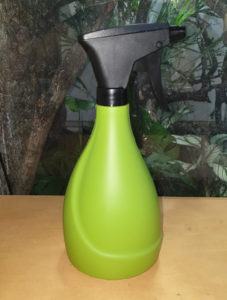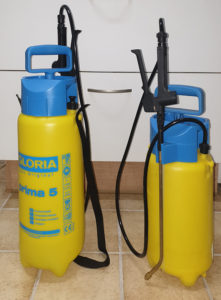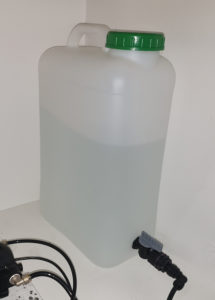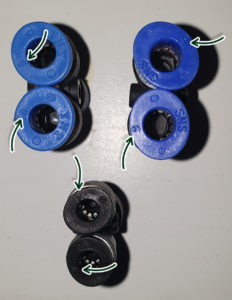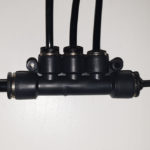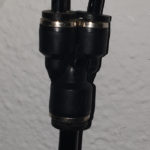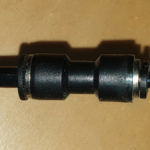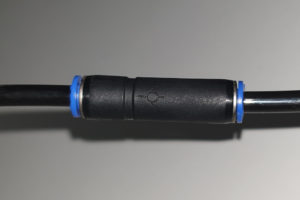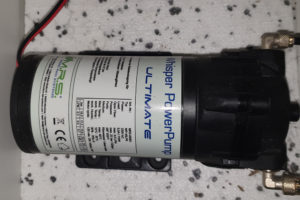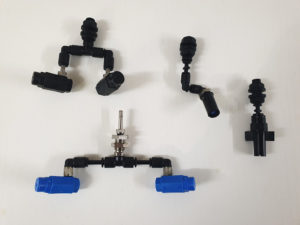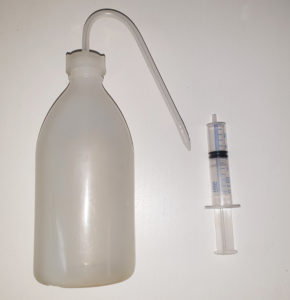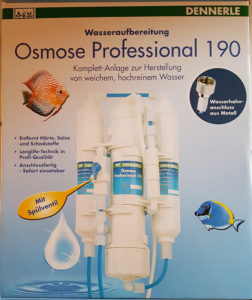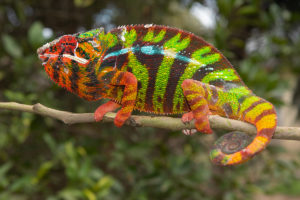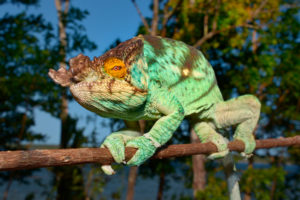Chameleons in Madagascar can be seen drinking mainly during rain and in the morning. They do not drink from stagnant water but actively take in moving water from plants or branches in particular. There is also evidence that the scaling of the head in chameleons helps direct rainwater toward the corners of the mouth. This article presents the various ways to provide water to a chameleon in a terrarium.
Inhaltsverzeichnis
Spray bottles
The simplest variant to ensure the water supply of a chameleon in the terrarium is simple spray bottles. They are available for a few dollars or euros in any hardware store or garden center. Spraying by hand is especially suitable for keepers of only a few chameleons or for single terrariums. A more practical version is a so-called pressure spray bottle, for example from Gloria. They have a larger reservoir and a pumping device to build up pressure. By operating a handle, you can then spray for quite a while without having to pump each time. Pressure spray bottles are available at garden centers, online,or at home improvement stores.
Drippers
Drippers offer a good possibility of a constant water supply. They are often very well accepted by chameleons due to the movement of the water drops and can run for hours in the terrarium. One disadvantage is that if large amounts of water are used during the day, there must be either very good drainage in the substrate or a drain. A catch basin for the dripping water in the terrarium is not recommended. Likewise, dripped water should not be reused as with fountains and waterfalls. Drippers should be allowed to dry completely on a regular basis to counteract the formation of slime films from certain bacteria, and in addition, should either be disposed of or cleaned on a regular basis.
Inexpensive and practical, you can build a dripper yourself from infusion or PET bottles and infusion sets. Here you can find instructions on how to do it. The advantage of this dripper is that it can be completely renewed regularly because of the low price and thanks to the long hose it can be placed anywhere in the terrarium. A disadvantage is that you generate additional plastic waste with this dripper.
Commercial drippers often have containers that are placed inside the terrarium. This takes up unnecessary space from the chameleon, so should be avoided. Also, with commercial drippers, make sure that all parts are easy to clean, e.g., wide-necked water containers and drippers that can be completely unscrewed. Drippers can very well be used – in addition to sprinkling -daily or every other day.
Automated rain systems
Automated rainwater systems offer a great advantage: they run even when you are not at home or otherwise busy. They can be controlled by a timer and thus also bridge vacation days. Rain systems consist of a water tank, a pump, hoses in several diameters, distributors, check valves, and rain nozzles. An example diagram of the construction of a rain system for the operation of four double or single nozzles is shown below.
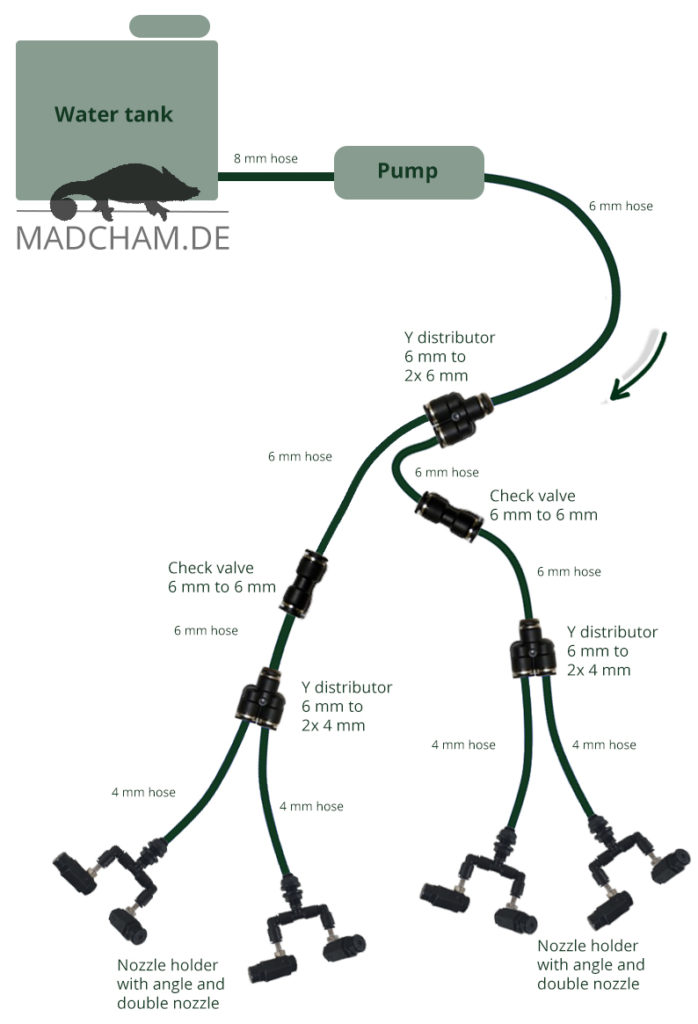
Before buying a rain system, it is important to be clear about what exactly you need: How many nozzles are to be operated simultaneously through one system? Which terrariums are to be irrigated? It is important to remember that the spraying intervals at all nozzles of a rain system are the same. If you operate nozzles in different sized terrariums via the same rain system, it can happen that the plants in the large terrarium remain too dry, while the much smaller terrarium literally bogs down under the same spraying interval. In parallel, you should consider how many meters of hoses of what diameter need to be laid where in total. For larger distances or several rooms, it is often worthwhile to have a second rain system with its own pump.
Water tank
As a water tank, canisters with a wide-necked opening are particularly suitable, as they can be cleaned easily. The size of the tank depends mainly on how many nozzles on which pump you want to be able to operate and for how long. For single or few chameleon terrariums 10 to 15 l canisters are well suited.
Wide-neck tanks are even available from various rainwater system suppliers with built-in “dry-running protection”. This is a sensor that detects the water level and simply switches off the current of the rain system when the water level is too low. If you irrigate the terrarium very evenly in always the same intervals, however, you can also simply calculate when the tank must be refilled.
Hoses, connectors and distributors
Pressure hoses are needed to transport the water from the pump to the nozzles. Common diameters are 4, 6, 8, and 10 mm. The hose directly behind the pump is usually 8 or 10 mm in diameter. The diameter decreases logically towards the nozzles, 4 mm hoses usually fit the nozzles themselves.
Behind the pump, a Y- or T-distributor can be used to divide a single hose into two hoses, or a straight-through distributor can be used to divert several hoses from the main hose. If you have fewer nozzle heads to supply than distributor openings, you can close the remaining opening with a blind plug. With so-called reducers, you can connect a hose with a larger diameter to a hose with a smaller diameter. Connectors, on the other hand, merely join two hose sections of the same diameter. If you want to lay hoses “around corners”, you can use 90° angle connectors, so-called L-pieces, for this purpose.
All connectors and manifolds have a small number on both sides. This number indicates which hose diameter can be connected to the respective side. Before buying a rain system, you should calculate how many manifolds (distributors) and reducers you need. The easiest way is to sketch out how many nozzle heads are needed and how many meters of the hose is needed in which diameter, as shown in the graphic above.
Check valves
Check valves are actually suitable for any rain system. They ensure that water still standing in the hoses does not drip from the nozzles when the rain system is switched off. This means that the hose system does not run empty and water is immediately sprinkled the next time the system is switched on. If there is no check valve, the pump needs a few seconds in which only “air is sprayed” until water has again passed through the hoses to the nozzles. There is an arrow on the valves indicating the direction of the water being pumped to make it easier to install “the right way around”. The check valve belongs between the pump and the rain nozzle.
Pumps
Oscillating piston pumps are very inexpensive to operate and were often used as spare parts for coffee machines in the past. Many terrarium enthusiasts have used them to assemble their own do-it-yourself rain systems. Oscillating piston pumps are characterized in operation mainly by an enormous sound. Such a pump must never run dry, otherwise, it will break down.
Somewhat less inexpensive, but much more pleasant in daily operation are so-called “whisper pumps” or diaphragm pumps. These usually have 24 V at 8.5 to 22 bar pressure. They are – hence the name – virtually silent in operation except for a quiet, buzzing vibration. While they should also not run dry, they survive without water for just under two minutes, so won’t break immediately with an accidentally empty water tank. Depending on the power of the pump, you can attach single or up to 20 rain nozzles and thus irrigate several terrariums at the same time.
Nozzles
Nozzles for rain systems usually consist of a nozzle head, connection angle, and, if necessary, connecting elements. At best, the nozzle can be swiveled, because this facilitates the alignment of the nozzle in the terrarium. For mounting, mostly bulkhead fittings are used, to which a hose can be connected directly. Nozzles are mounted directly in the terrarium lid or high up on the back and side walls. Nozzle heads are available in plastic and metal. Plastic nozzle heads are less expensive but are generally more susceptible to limescale buildup and more difficult to clean, so overall they are less usable for a long time than metal nozzles. There are also nozzle heads with different spray cones. Common are 80° for smaller terrariums and 105°, 120°, or 150° nozzle heads for larger terrariums. The larger the spray cone, the larger the irrigated terrarium area.
Lastly – and actually one of the most important criteria when selecting suitable nozzles – different nozzle heads produce different droplet sizes. Rain nozzles usually produce droplet sizes of more than 50 µm, 90 µm is common. However, since there is no uniform designation among the manufacturers, it is always worthwhile to look at or ask about the actual droplet size produced even with “rain nozzles”.
Fog nozzles, on the other hand, usually spray much finer, depending on the pressure that can be generated by the pump in the hose system. Slightly weeping fog in nature has a droplet size of 5 to 10 µm. In dense weeping fog (classical in rainforests) the droplet size in nature varies between 10 and 20 µm, in heavy weeping fog (also found in rainforests) even up to 50 µm. So in the terrarium fog nozzles between 5 and 50 µm can be used. The difference in droplet size to foggers is explained here.
The nozzles must be cleaned regularly, otherwise, they will calcify and stop spraying. You can unscrew them and then soak them in vinegar or citric acid for a few hours to get the lime out. After that, be sure to rinse the nozzles thoroughly with water before using them again in the terrarium.
Watering by hand
You can water chameleons directly by hand with a slow-dripping pressure spray bottle, Pasteur pipettes, syringes, or spray bottles from laboratory supplies. However, the chameleon must be acclimated to it. To do this, take advantage of the water supply that is already available: If the terrarium is just wet from the rain system, let the water drip slowly by hand near the chameleon for a few minutes. Once it is used to it, approach the animal until it is dripping right in front of the chameleon’s nose. Most chameleons will eventually turn to the dripping water and drink from it.
For many species like Calumma parsonii parsonii or Furcifer pardalis it is worthwhile to practice daily watering by hand. It takes time for chameleons to learn, but this is a good way to ensure a steady supply even during “dry periods”, especially for species with high water requirements. For practical reasons, we strongly recommend teaching chameleons to drink by hand or from a dripper.
For outdoor enclosures: Perl hoses
A wonderful option for supplying water to chameleons in outdoor enclosures are so-called perl hoses. These are garden hoses made of porous material that release water drop by drop when connected to a normal water hose. If you attach several rows of perl hoses to outdoor enclosures using cable ties, for example, you get a rainfall that almost perfectly imitates natural rain. We now use perl hoses for all our outdoor enclosures. They are available from various brands in any DIY store or garden centre in Germany. In Europe, this type of hose seems to exist in a number of other countries, too. They were actually invented for watering large lawns or flower beds. Unfortunately, we do not currently know whether they are also available in the USA or outside the European Union (please send us any information by e-mail!).
Which water to use?
Tap water
Tap water is certainly the most practical, as it is available in all households. In Germany, tap water is usually of drinking water quality. So in principle, it can be used for the water supply in the terrarium. In other countries, this is not generally the case. Some countries strongly chlorinate their tap water. Such water should not be used for the water supply of chameleons. In general, tap water has one other disadvantage: If it is very hard and therefore very calcareous, it will quickly clog the sprinkler nozzles. In addition, ugly white residues settle on the plants in the terrarium.
Rainwater
Rainwater usually has only a low calcium content and is similar to osmosis water in terms of content. It can be collected in rain barrels or cisterns and then used in the terrarium. Coarse impurities such as leaf debris should be filtered out before use to avoid clogging the rainwater systems.
Distilled water, demineralized water, osmosis water
Distilled water (Latin: Aqua destillata) is tap water that has been freed from salts, microorganisms, organic substances such as sulfur or nitrogen, or trace elements by distillation. However, the “distilled” water available on the market is not “real” distilled water, but usually only demineralized water. In terraristics, it is known as “osmosis water”, since it can be obtained by reverse osmosis.
You can buy plastic canisters of “distilled” water at the supermarket, gas station, or hardware store. If you want to use less plastic and save money overall, you can buy a small reverse osmosis system and simply make your own osmosis water. Osmosis water has the great advantage that it neither clogs rain nozzles nor leaves residues on plants. It is therefore simply more practical than tap water for long-term use.
There is a persistent myth in terraristics that osmosis water is harmful to chameleons (and humans) when ingested orally. However, in the quantities used to supply water to chameleons in the terrarium, osmosis water is completely harmless.
Spraying intervals
How often and how intensively you spray the terrarium with water depends mainly on the habitat of the chameleon. The year is divided throughout Madagascar into a warmer rainy season and a cooler dry season. However, how much rain falls during the “dry season” varies greatly in different habitats. While in the south of Madagascar near Tolagnaro sometimes no drop of rain falls for weeks during the dry season and the only water supply is via morning dew on plants, in the rainforests of the east coast around Mananara, Marojejy, or Sambava it rains almost daily even during the dry season. Basically the following applies in the terrarium: Each chameleon should be given the opportunity to take in water several times a day. The complete terrarium should be wetted with water. However, the terrarium should be able to dry completely afterward – keyword ventilation surfaces – and should not be permanently dripping wet.
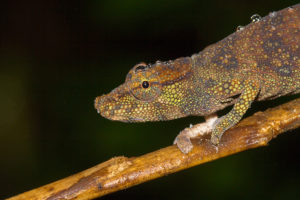
Calumma tjiasmantoi female after rainfall in Ranomafana rainforest
In principle, more and more intensive spraying should be done during the rainy season than during the dry season. In Europe, it is usually useful to reverse the seasons of Malagasy chameleons, so that our summer corresponds to the rainy season of the chameleon and the cooler winter to the dry season. With captive bred chameleons this is usually possible without any problems. But be careful with wild-caught chameleons from Madagascar! For these, the seasons are reversed and they are often difficult to “adjust” to European conditions. Wild-caught chameleons from Madagascar know that from November to March there is the rainy season and from April to October dry season. Their rhythm is therefore exactly the opposite of our European seasons.
By the way, the spraying intervals must also depend a little on the planting of the terrarium and the substrate. In heavily planted terrariums, a strongly rooted substrate can absorb much more water than in a freshly set up tank with just transplanted single plants. Drainage or runoff will also provide better sprinkling opportunities in the terrarium.

